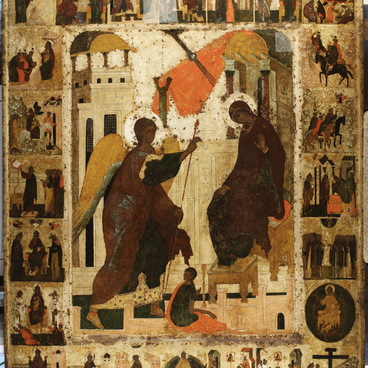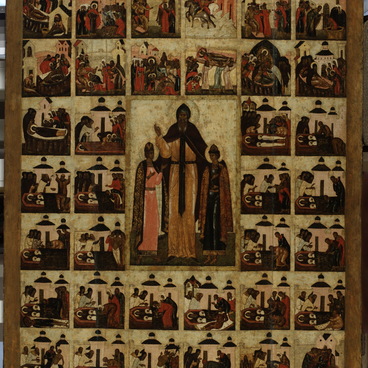The icon Our Lady of Vladimir from the collection of the Yaroslavl Museum Reserve belongs to one of the main image types of the Virgin with the infant Christ, the Virgin of Tenderness (Eleusa). The Holy Virgin on the icon is depicted half-length. On Her right arm, She holds the Infant who nestles against Her cheek. The image emphasizes not the regal grandeur and sternness of the Theotokos and Child, characteristic of the iconography of other types, but the touching feelings of mother and child. One of the characteristic features of the icon is the position of Christ’s left leg: the foot is turned towards the worshipers.
Our Lady of Vladimir
Время создания
Mid-16th century
Размер
118x92 cm
Техника
Tempera
Коллекция
Выставка
7
Открыть в приложении#1
Unknown author
Our Lady of Vladimir
#6
#7
Presumably, the Yaroslavl icon was created by a visiting Moscow artist who painted the murals of the Spassky Monastery cathedral in the middle of the 16th century. The clothes of the Virgin and Jesus are painted in the shades that were traditionally used for icons at the time. The figure of Christ is highlighted with contrasting honey-yellow and emerald-green colours against the cherry maphorion of the Virgin Mary. The original paint layer of the icon is poorly preserved: there is loss of pigment on the haloes, and of gold on the background.
#8
The side borders of the icon feature full-length figures of Athanasius of Alexandria and St. Sergius of Radonezh. Athanasius of Alexandria was one of the saints that were venerated in Byzantium and the countries close to it. In the monuments of Russian culture, he came to be often depicted in icons since the end of the 15th century. St. Sergius of Radonezh was one of the most revered saints and spiritual authorities of Ancient Russia. Most likely, the image of the Virgin Mary and Child was commissioned as a gift to a church, and the saints depicted along the borders were especially revered in the customer’s family.
The icon follows the 12th-century Byzantine image of the Virgin, one of the most revered relics of Ancient Rus. According to legend, the first image was painted by the Evangelist Luke. A copy of it was brought to Rus in the 12th century; it was located in Kiev. Later, Prince Andrei Bogolyubsky transferred the relic to the Assumption Cathedral of the city of Vladimir, where the icon became famous as miraculous and got its name, Vladimirskaya (of Vladimir). Today it is stored in the Tretyakov Gallery. The image from the collection of the Yaroslavl Museum Reserve accurately follows the iconography of Our Lady of Vladimir.
#9
Yaroslavl Museum Reserve
читать дальшескрыть
00:00
00:00
1x
Our Lady of Vladimir
Время создания
Mid-16th century
Размер
118x92 cm
Техника
Tempera
Коллекция
Выставка
7
Открыть в приложении
Поделиться



